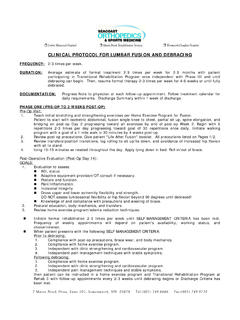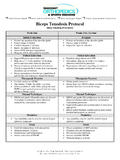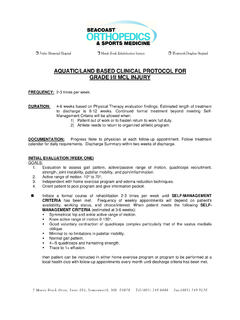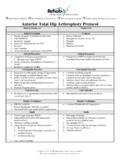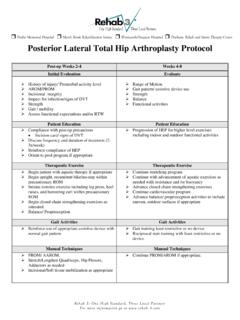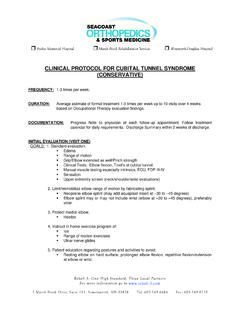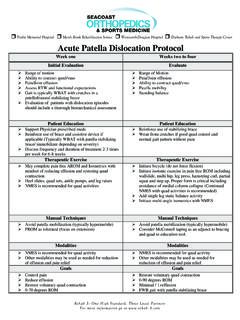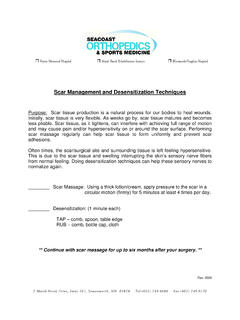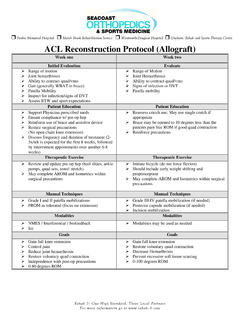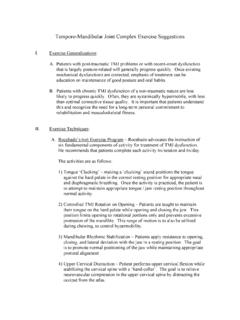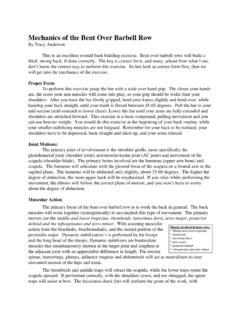Transcription of Non-Operative Rotator Cuff Tear Protocol
1 Frisbie Memorial Hospital Marsh Brook Rehabilitation Service Wentworth-Douglass Hospital Durham: Rehab and Sports Therapy Center R e h a b 3 : O n e H i g h S t a n d a r d , T h r e e L o c a l P a r t n e r s F o r m o r e i n f o r m a t i o n g o t o w w w . r e h a b-3 . c o m Non-Operative Rotator cuff Tear Protocol Acute/early phase (limited, painful AROM, painful resisted testing) Sub-acute/mid phase (~ full AROM, minimal to no pain with resisted testing) Initial Evaluation Evaluate Pain assessment Posture, scapulo-thoracic/humeral position Active/passive shoulder range of motion Capsular mobility, scapular/thoracic mobility Shoulder, scapular strength Assess functional/sport expectations Posture, scapulo-thoracic/humeral position Thoracic mobility Shoulder, scapular strength Assess functional/sport expectations Patient Education Patient Education Correct postural adaptations Daily functional postural modification Activity modification, as indicated Emphasis of HEP compliance (flexibility exercises daily, strengthening exercises 3x/week)
2 Continue with postural correction Activity modification initiation, as indicated Emphasis on HEP compliance (flexibility exercises daily, strengthening exercises 3x/week) Therapeutic Exercise** Therapeutic Exercise** AAROM of shoulder ( table-top, cane, pulley, MET) Postural mobility ( self thoracic mobs) Postural setting exercises ( scapular retraction, UBE retro, thera-band rows, extension) Dynamic stab ( RC, add, scapula) (short lever arm long lever arm, isometrics isotonics) Shoulder/capsular stretches ( pec minor) Continue postural mobility Advance shoulder/capsular stretches ( towel stretch behind back, posterior capsule stretch) Initiate Rotator cuff strengthening ( IR/ER with thera-band, sidelying ER), deltoid program Progress scapular muscle training ( prone extension, prone horizontal abduction, prone row, prone row into ER, table press downs, W , push up plus, dynamic hugs, wall slides) Manual Techniques Manual Techniques GH mobilization* Scapular/thoracic mobilization* Soft tissue mobilization, as indicated ( pec minor, infraspinatus, teres minor, UT)
3 Deep friction massage, as indicated Thoracic mobilization* Soft tissue mobilization , as indicated ( pec minor, infraspinatus, teres minor, UT) Deep friction massage, as indicated Goals Goals Decrease/diminish pain Normalize motion Increase capsular mobility Establish dynamic stability (IR/ER) Demonstration of postural correction Activity modification, as needed Independent/compliant HEP Maintain postural correction Increase shoulder/scapular strength Advance dynamic stability Independent/compliant HEP * Based on joint mobility deficits based on evaluation ** Exercises within each category are to provide the clinician with examples based on evidence based research, but are not all inclusive Frisbie Memorial Hospital Marsh Brook Rehabilitation Service Wentworth-Douglass Hospital Durham: Rehab and Sports Therapy Center R e h a b 3.
4 O n e H i g h S t a n d a r d , T h r e e L o c a l P a r t n e r s F o r m o r e i n f o r m a t i o n g o t o w w w . r e h a b-3 . c o m Chronic/Late Phase (full, painfree ROM, painfree resisted testing) Special Considerations Evaluate Findings consistent with hypermobility Posture, scapulo-thoracic/humeral position Thoracic mobility Shoulder/scapular strength Endurance/stability Readiness to return to sport/activity Focus on neuro-muscular re-education, proprioception Optimize static and dynamic stabilization Balance the shoulder complex to optimize shoulder mechanics Patient Education Findings consistent with internal impingement Review postural correction with sport/activity Emphasis gradual return to sport/activity Continue emphasis on HEP compliance (flexibility exercises daily.)
5 Strengthening exercises 3x/week) Posterior shoulder pain during shoulder abduction and end-range ER (results in supraspinatus and infraspinatus contacting glenoid rim/labrum becomes susceptible for fraying of the cuff ) Balance shoulder ROM, improve IR ROM Promote shoulder girdle stabilization Focus on postural correction Therapeutic Exercise** Continue with ROM, flexibility/mobility exercises Progress shoulder/scapular strengthening ( full can, stability ball scapular strengthening (prone/seated), side plank with shoulder ER) Initiate endurance exercises ( sustained holds, wall ball IR/ER, plank) Specificity training to promote return to sport/activity ( IR/ER with increased elevation, PNF patterns, Wilk Fundamental Exercises)
6 Manual Techniques Thoracic mobilization* Soft tissue mobilization , as indicated Goals Maintain flexibility of shoulder girdle, thoracic spine Progress shoulder/scapular strength Increase shoulder girdle endurance Promote safe return to sport/activity Transition to continued independent HEP * Based on joint mobility deficits based on evaluation ** Exercises within each category are to provide the clinician with examples based on evidence based research, but are not all inclusive Frisbie Memorial Hospital Marsh Brook Rehabilitation Service Wentworth-Douglass Hospital Durham: Rehab and Sports Therapy Center R e h a b 3 : O n e H i g h S t a n d a r d , T h r e e L o c a l P a r t n e r s F o r m o r e i n f o r m a t i o n g o t o w w w.
7 R e h a b-3 . c o m References Bang M, Deyle G. Comparison of supervised exercise with and without manual physical therapy for patients with shoulder impingement syndrome. Journal Of Orthopaedic & Sports Physical Therapy [serial online]. March 2000;30(3):126-137. Available from: CINAHL, Ipswich, MA. Accessed August 6, 2015. Escamilla R, Yamashiro K, Paulos L, Andrews J. Shoulder muscle activity and function in common shoulder rehabilitation exercises. Sports Medicine [serial online]. August 2009;39(8):663-685. Available from: CINAHL, Ipswich, MA. Accessed August 6, 2015. Harris JD1, Pedroza A, Jones GL; MOON (Multicenter Orthopedic Outcomes Network) Shoulder Group.
8 Predictors of pain and function in patients with symptomatic, atraumatic full-thickness Rotator cuff tears: a time-zero analysis of a prospective patient cohort enrolled in a structured physical therapy program. Am J Sports Med. 2012 Feb;40(2):359-66. doi: Epub 2011 Nov 17. Kuhn, JE. Exercise in the treatment of Rotator cuff impingement: a systematic review and a synthesized evidence-based rehabilitation Protocol . J Shoulder Elbow Surg. 2009 Jan-Feb;18(1):138-60. doi: Epub 2008 Oct 2. Kukkonen J, Joukainen A, A rimaa V, et al. Treatment of non-traumatic Rotator cuff tears: A randomised controlled trial with one-year clinical results.
9 Bone & Joint Journal [serial online]. 2014;96(1):75-81. Available from: CINAHL, Ipswich, MA. Accessed August 6, 2015. Reinold M, Escamilla R, Wilk K. Current concepts in the scientific and clinical rationale behind exercises for glenohumeral and scapulothoracic musculature. Journal Of Orthopaedic & Sports Physical Therapy [serial online]. February 2009;39(2):105-117. Available from: CINAHL, Ipswich, MA. Accessed August 6, 2015.
